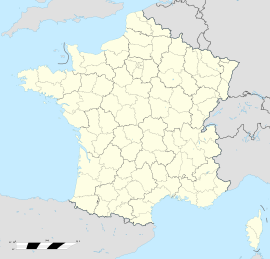- Crémieu
-
Crémieu
Administration Country France Region Rhône-Alpes Department Isère Arrondissement La Tour-du-Pin Canton Crémieu Intercommunality Communauté de communes de l'Isle-Crémieu Mayor Alain Moyne-Bressand (UMP)
(2008–2014)Statistics Elevation 203–415 m (666–1,362 ft)
(avg. 288 m/945 ft)Land area1 6.14 km2 (2.37 sq mi) Population2 3,330 (2006) - Density 542 /km2 (1,400 /sq mi) INSEE/Postal code 38138/ 38460 1 French Land Register data, which excludes lakes, ponds, glaciers > 1 km² (0.386 sq mi or 247 acres) and river estuaries. 2 Population without double counting: residents of multiple communes (e.g., students and military personnel) only counted once. Coordinates: 45°43′33″N 5°15′08″E / 45.7258333333°N 5.25222222222°E
Crémieu is a commune in the Isère department in south-eastern France.
It is located near Bourgoin-Jallieu, about 25 miles east of Lyon.
Contents
Early history
Crémieu has a long and important medieval history. First historical references to Cremieu date back to the 12th century, when a benedictine priory was built high on the cliffs of Saint-Hippolyte. the town itself, however, grew up during the 13th century, the southern slopes of Saint-Laurent hill and overlooking the walls of the royal castle which the Dauphins of La Tour began to restore in 1282. In 1315, the town was granted important civis and trading rights which marked the beginning of two centuries of prosperity. Building of a new covered market started in 1434, as did the construction of afortified wall, almost 2 kilometers long, with 9 gates and 14 towers. The wall encircled not only the royal castle, the old town and the cliff of Saint-Hippolyte, but also the site of a new town below, next to an augustinian monastery. In 1357, a mint was set up at Crémieu, making it even ore prosperous. From the reign of Louis XII (1498-1515), Crémieu benefited from its strategic position on the route of french expeditionary forces bound Italy. The town became a major trading centre in cereals for France, Savoy, Switzerland and Italy. As early as the 15th century, it had an important Jewish community. Raoul de Gaucourt, governor of Dauphiné, renewed the privileges of the Jews in 1441 for seven years in consideration of the sum of 50 florins, which Moses Dandéli of Crémieu and Aguinet Solomon of Saint-Symphorien, Jewish residents, were to collect from their coreligionists. The Jews of Crémieu refused to pay the sum and emigrated in large numbers. The dauphin Louis XI of France recalled them in 1449, and promised them that if they would reopen their banking-houses, he would tax them only one ounce of fine silver in the future, instead of the half-mark that they had formerly been required to pay. New gates were built in 1535 and the lower town, design along the lines of most medieval "new towns", was completed at the beginning of the 16th century. The 17th century brought monasteries and convents to Crémieu, where trade was by now beginning to flag. The Capuchins settled there in 1615, The white Penitents in 1619, the nuns of the order of Visitations in 1627, the ursuile nuns in 1633, the Notre-Dame du Reclus hospital opened in 1675 and the church of Saint-John was completed by the end of 17th century. The town's economic decline finalised by the supression, in 1702, of the annual trade fairs dating back to the 14th century, led the townspeople to turn to the leather and textile industries during 18th century. In 1710, quarter of the population was working as tanners, cobblers carders (of both hemp and wool) and spinners. In the next century, the plateau of Isle-Cremieu and the sleepy town below the ruins of the castle and ramparts began to attract landscape artists, led by Corot, as well as travellers, tourists and lovers of all things beautiful.
Demography
The residents of the city are known as "Crémolan".
References
This article incorporates text from the 1901–1906 Jewish Encyclopedia, a publication now in the public domain. ([1])
Bibliography from Jewish Encyclopedia:- Prudhomme, Les Juifs en Dauphiné, p. 64.
See also
Categories:- Historic Jewish communities
- Communes of Isère
- Jewish history stubs
Wikimedia Foundation. 2010.

